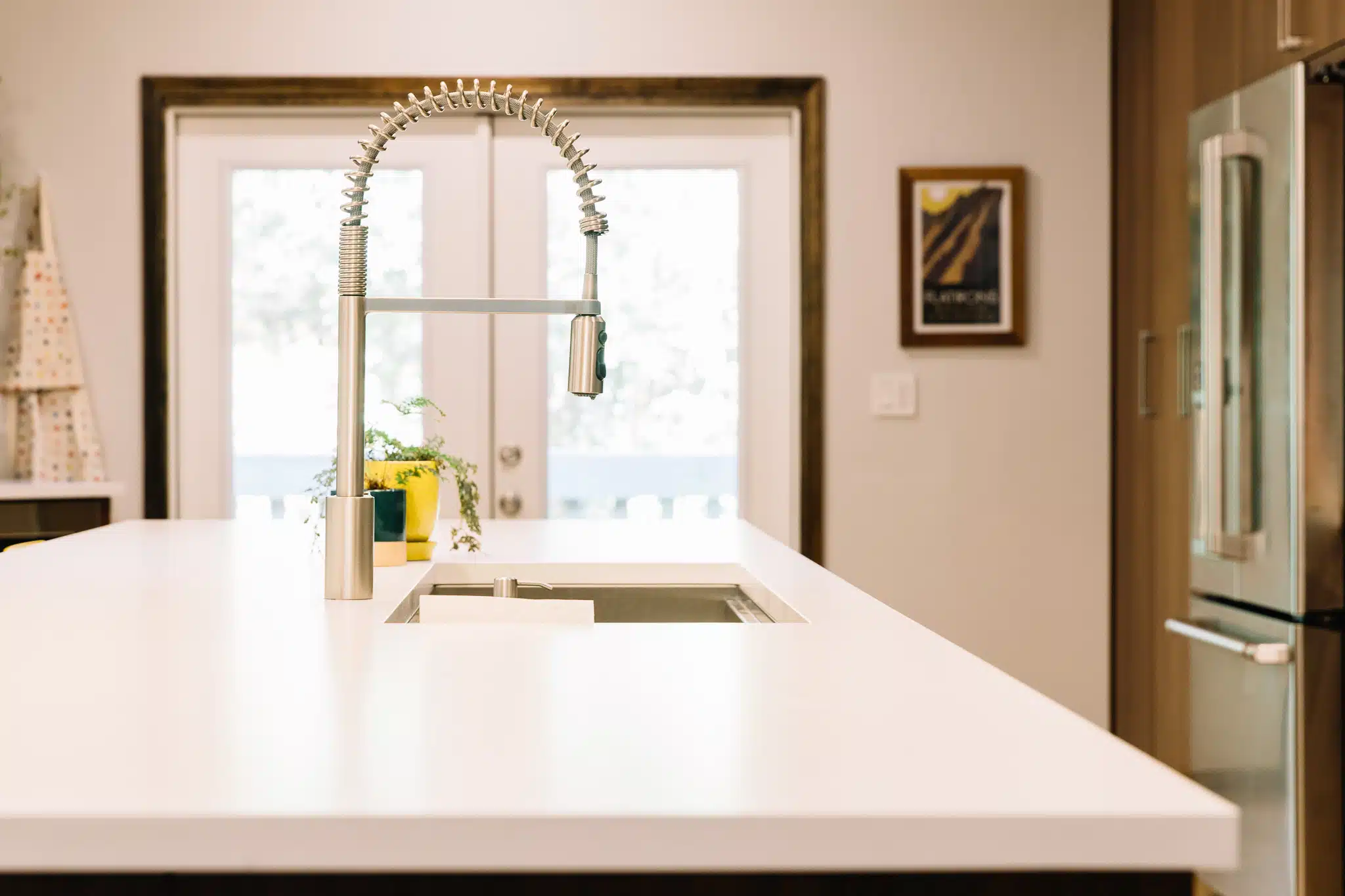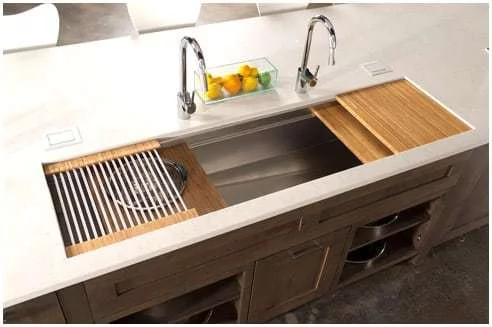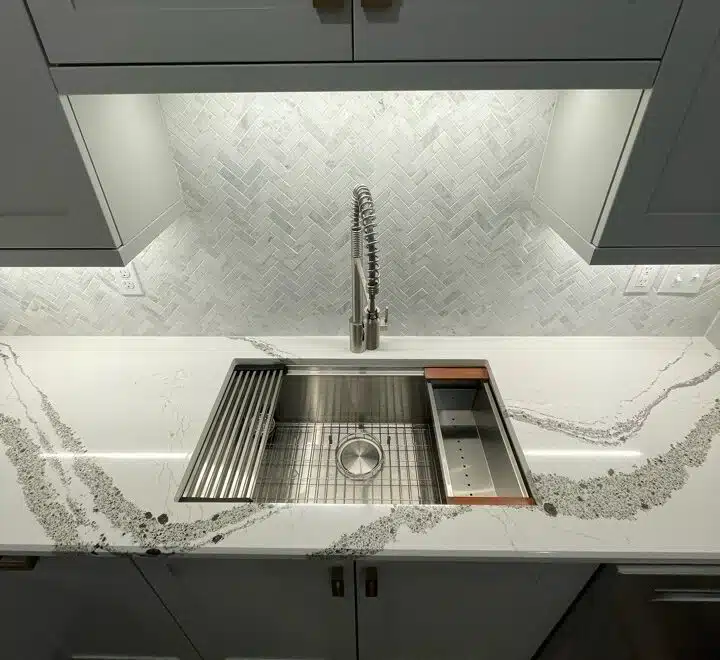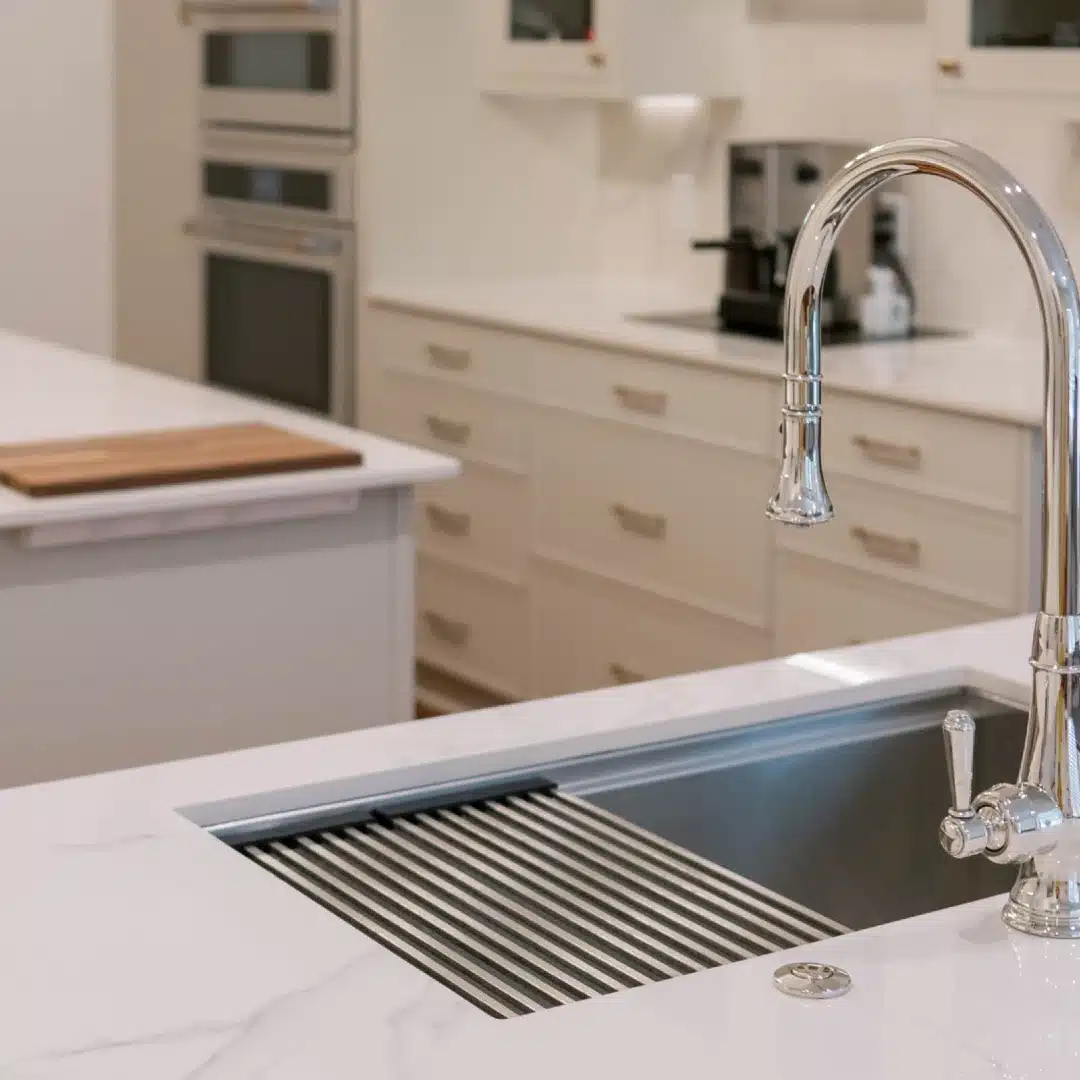
Apron front sinks have a unique look and provide a durable “apron” at the sink area to protect your cabinets.
Kitchen Sink Options: Your Complete Guide
Kitchen sinks are used more than any other sink in the house, and more than many appliances and other home features. They’re hard-working and necessary for your kitchen to function well.
Whether you’re doing a complete kitchen remodel or just need to replace your sink and faucet, when it comes time to choose a new sink for your kitchen, there are so many choices that it can be hard to know what’s best for you.
The perfect kitchen sink should be functional, durable, easy to clean, and should look great in your space. We are here to help you find it.
In this kitchen sink guide, you’ll find information about types of sinks, installation, materials, and more. You can feel confident in your decision and happy with your new sink for years to come.
McManus Kitchen and Bath is a full service remodeling company with an in-house design team and showroom right here in Tallahassee, FL.
We work exclusively with homeowners to help them remodel using a design-build approach that saves time, avoids confusion and creates better results.
Measure First
It’s important to know what size sink you need before you start looking. You can always adjust your counters and cabinets to accommodate a larger or differently-sized sink, but that makes the installation a much bigger project. Measure the following:
- your counter depth, from the wall to the edge of the counter.
- your current sink width.
- your current basin depth. Again, you can certainly change this, but it will affect the space you have under your sink (for a garbage disposal, water filtration system, etc), so be aware if you’re going from a shallow sink to a deeper one, that other plumbing adjustments may be necessary.
A standard single-bowl sink is usually 22 inches long. Farmhouse and double-bowl sinks can be anywhere from 32 to 48 inches long. A standard-width sink is usually 24 to 32 inches from the front to the back. And the depth is generally 8 to 10 inches (you can definitely get a deeper sink, but be aware that it will take up more space in your lower cabinet).

Undermount sinks look better and make wiping things off the countertop into the sink easier.
Kitchen Sink Installation Types
After you know the size of the sink you need, you can decide what installation type you like best. With kitchen sinks, the installation type is related to the style–each type has a different look.
Drop-In Sinks
The most common design, drop-in sinks have a lip that sits on top of the counter, holding the sink in place, while the rest of the sink rests in a hole cut into the countertop. The lip is often sloped or rounded to help keep water in the sink and off your countertops. Drop-in sinks are the easiest type to install and so generally cost less than other styles.
Undermount Sinks
Undermount kitchen sinks are mounted from the underneath of the countertop, so the edge of the countertop is at the edge of the sink. They are easier to keep clean (you can brush crumbs and debris right into the sink without them getting caught in the sink edge), and they have a sleek, modern look. They work best with sturdier countertops (like granite or quartz) that can support the weight more easily. Undermount sinks are harder to install and generally cost a little more than drop-in sinks.
Flush Mount
A type of drop-in sinks, flush mount sinks are inset in the counter and do have an edge that supports them, but instead of a rounded lip, it’s a flat edge. This means it’s easy to keep clean and has a modern, clean-lined look. Because the sink edge is perfectly flush with the counter edge, it can be tricky to install.
Farmhouse
Farmhouse-style sinks need a different type of installation because of the apron, or front of the sink. The lower cabinet will be shorter to accommodate the apron, which serves as a front panel of the sink.
Other Types
Integrated sinks are built right into the solid-surface countertop. These are more common in bathroom vanities than as kitchen sinks, but in a smaller kitchen or as a secondary sink, they can work well.
Dual-mount sinks can either be installed from the top (drop-in) or underneath the counter (undermount), making them a versatile option.

Work Station Sinks
One special kind of sink you may want to consider is a work station sink (also known as a galley sink). This term refers to a sink that has tracks built in to allow you to use the sink area for food prep, serving, and clean up. Work sinks often include cutting boards, colanders, dish drying trays, serving trays, and more, organized into “decks” so you can use more than one feature at a time. They are hardworking, sleek, and incredibly useful.
Choosing a Kitchen Faucet
Usually when you replace a kitchen sink you need a new faucet as well. We also have a kitchen facuet guide.

Workstation sinks have become very popular and come with accessories like drying racks and collanders.
Number of Basins
Most sink configurations have either one or two basins (or bowls), although some have three. Double-basin sinks were the most popular for years, but now the trend is moving toward deep, single-basin sinks. There are pros and cons to both styles.
Double-basin sinks
- allow you to use one side for soaking or washing dishes and leave one side free for washing food or filling pitchers.
- are often better for very busy kitchens, since they give you two workspaces.
- can have basins of two different sizes for different purposes.
Cons
- can make washing large items more difficult.
- are often not as deep as single-basin sinks.
Single-basin sinks
- often have a larger, deeper basin with more flexibility for washing or soaking large items.
- Easier to clean
- They only have one drain which makes plumbing simpler and creates more room for storage underneath
Cons
- can limit flexibility of use, because if the sink is holding or soaking dishes, there’s no space for anything else.
- Only one drain to connect disposal too

Kitchen Sink Material Options
When deciding what you want your kitchen sink to be made of, there are a few questions to consider. First, how durable does it need to be? Do you have a busy household with a lot of kids running around? A high-traffic kitchen needs a sturdy sink. But if your home is quieter or you don’t cook every day, an eye-catching, beautiful sink might be a higher priority to you than a very durable one.
#1. Stainless Steel
Stainless steel sinks have been popular for years and remain one of the top options for kitchen sinks–and for good reason. They look good, are very durable, and resist heat, dents, and scratches. They are eco-friendly since they are recyclable and are sometimes made of recycled materials. They come in multiple finishes from mirror finish which is very shiny to matte, satin, and textured, which are less shiny but hide water spots better. Satin is the most popular choice because it hides water spots and imperfections but still looks gorgeous.
Stainless steel comes in multiple gauges, or thicknesses. The most common are 16-, 18-, and 20-guage. The lower the gauge, the thicker and more durable the material.
#2. Enameled Cast Iron
This type of sink is generally white and often a farmhouse style. It resists chips, cracks, and staining, and can handle high heat. Cast iron sinks are beautiful and durable, with a charm that makes them a popular choice for many styles of kitchen. Because they are heavy, these types of sinks sometimes need to be reinforced for extra stability.
For a similar look but a less expensive price tag, consider enameled steel.
#3. Natural Stone
Stone sinks have a modern and classy look to them. They’re very durable but also very heavy. There are several types of stone sinks available:
- Granite (or granite composite) sinks are durable and resist heat and scratches. Any scratches that do occur can be buffed out. Because of the hardness of the materials, dishes can break more easily in granite sinks than some other types. Make sure cabinets and countertops are reinforced because of the weight of the sink.
- Quartz and quartz composite sinks naturally reduce noise and vibrations. While they are also very durable (resisting heat), they can develop stains and scratches. Quartz sinks are easy to clean and look beautiful.
- Granite and quartz combination sinks have a textured, sophisticated look that is stunning and hard to beat.
#4. Copper and Brass
While not the sturdiest option, a copper kitchen sink is maybe the most eye-catching choice available. Copper is naturally antimicrobial, and it develops a lovely patina over time. Copper farmhouse sinks, where the apron is textured, are gorgeous and unique, making a great focal point for your kitchen. Copper sinks do require a little maintenance to keep them looking good, and they can be more expensive than other types of sinks.
Brass sinks are similar to copper in their antimicrobial properties and their stunning look. They also develop a patina over time, although they can be sealed if you don’t care for that look and would rather keep the bright shine. A brass sink is expensive and not tremendously sturdy, so it needs to be treated gently. But if cared for well, it will make a great addition to your space.
#5. Fireclay
A fireclay sink is a type of ceramic sink that is often used for a farmhouse-style sink. Because fireclay sinks are made of clay and glaze molded together at high heat, they are durable and strong. The surface is non-porous, making them easy to clean (although the glaze can be damaged by harsh chemicals). While they do scratch sometimes, because the material under the finish is the same color, scratches aren’t very noticeable. Fireclay sinks look great and are sturdy enough for busy kitchens.
#6. Acrylic
Acrylic sinks are low-maintenance and come in many versatile styles. They are sound-absorbant naturally, and they resist mold and mildew growth. They are lighter-weight than most sinks, so installation is easier and the cost is generally lower. On the downside, they can be easily damaged if exposed to high heat, and they scratch fairly easily. Acrylic sinks have their place and will last–with care–but they aren’t the most durable sinks on the market.
#7. Porcelain
Porcelain is easy to clean and low-maintenance. It has a traditional look which makes it suited for a variety of styles and aesthetics. Porcelain sinks have a medium resistance to heat and stains. These sinks are sometimes reinforced with steel or cast iron, which makes them heavy. You may need to reinforce counters and cabinets.
#8. Vitreous China
Made by applying glass enamel to porcelain to increase its strength, vitreous china sinks have a lot going for them. They resist chips and stains and are easy to clean. Because they are non-porous, the surface is resistant to bacteria. They look great with a minimalistic design. The enhanced strength and glossy surface give them a higher price point than some other types of sinks.
Kitchen Sink Drain Placement
Make sure you consider the location of the drain in your new sink. Generally, your options are centered, off-center, and rear placement. Centered means the water drains faster, repairs are generally easier, and the drain lines up with the faucet, which may be important to you visually. Off-center is helpful for soaking and washing dishes because big pots or stacks of plates don’t sit directly on the drain and block it. However, repairs can be harder to do since the pipes may be in a corner of the lower cabinet. Rear drains mean more space under your lower cabinet and also a more convenient sink in terms of soaking and washing dishes. But installation and repairs are trickier due to the pipes being far back in the cabinet.
Number of Holes
Most sinks come with several pre-drilled holes that allow you to install a faucet and other accessories (sprayers, soap dispensers, and drinking water dispensers to name a few). This will guide you in choosing a faucet, although it’s possible to drill more holes if you need them, or to cover unused holes with a cover plate).
Want Some Inspiration In Your Inbox?
Know What You Want?
If you need more help deciding on the perfect sink for your home, or you want to look at and talk through some options, give us a call. We have a full showroom and designers who can listen to your needs and help you make the right choice. And if you want to give your home a whole new kitchen, we can help you with that as well. We serve many Tallahassee neighborhoods including Killearn Lakes, Betton Hills, Midtown, and more. Let us help you make your kitchen perfect for you and your family.
